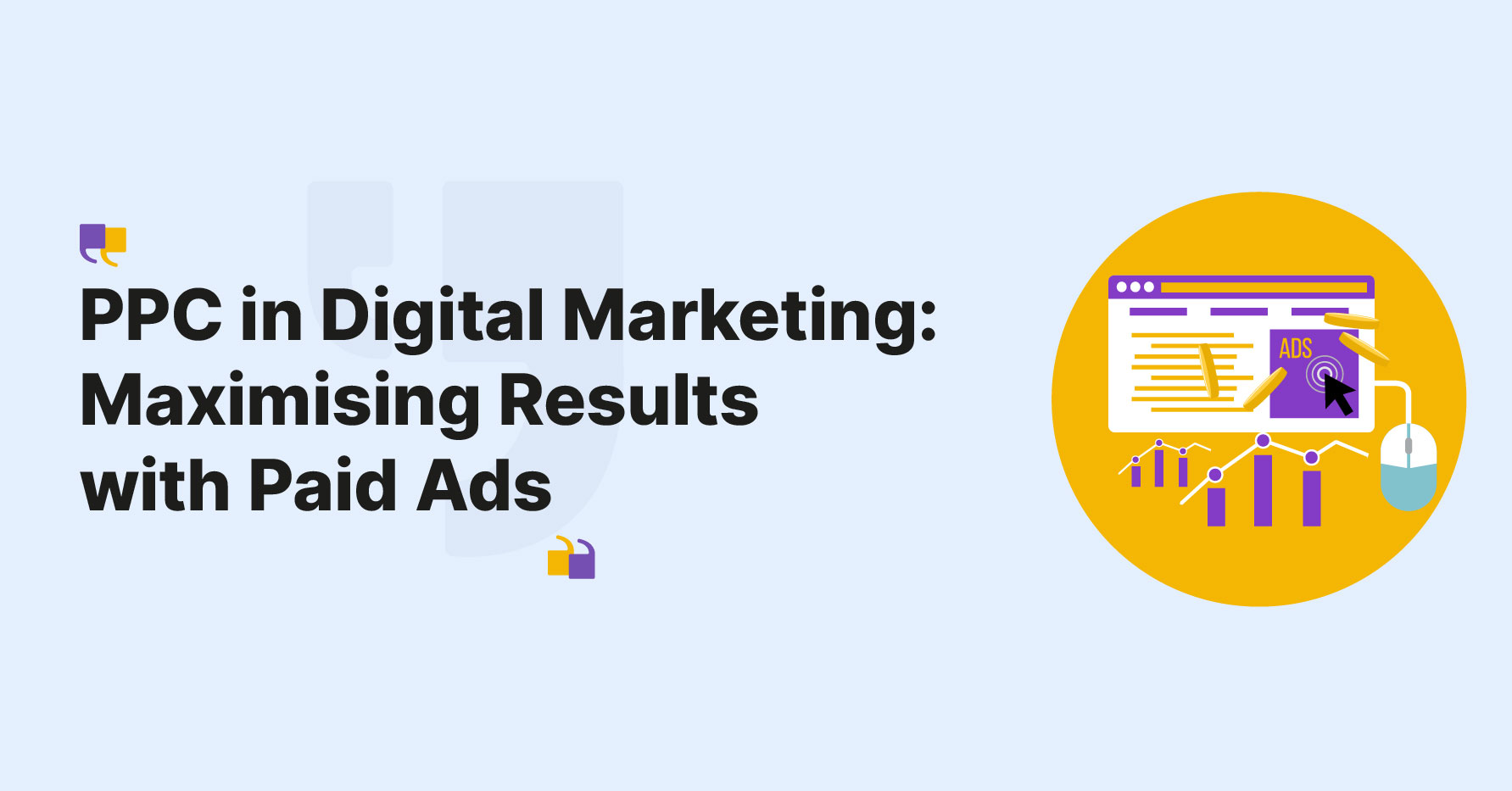In the rapidly evolving realm of digital marketing, companies are constantly seeking effective strategies to attract the interest of their desired audience and stimulate relevant traffic to their websites.
Pay-Per-Click (PPC) advertising has emerged as a game-changer in achieving these goals, allowing businesses to connect with potential customers at the perfect moment and generate tangible results.
In this article, let’s explore PPC, how paid ads work in digital marketing, and how businesses can leverage them to enhance their online presence and drive conversions.
Understanding PPC (Pay-Per-Click) in Digital Marketing
What is PPC?
PPC, or Pay-Per-Click, is an essential component of digital advertising. Advertisers incur a cost for every instance their ads are clicked. This digital marketing model is widely used to drive website traffic, with search engines being a popular platform for PPC ads.
Businesses participate in auctions by bidding on keywords relevant to their products or services. When users search for those keywords, the ads appear alongside the search results.
How does PPC Work?
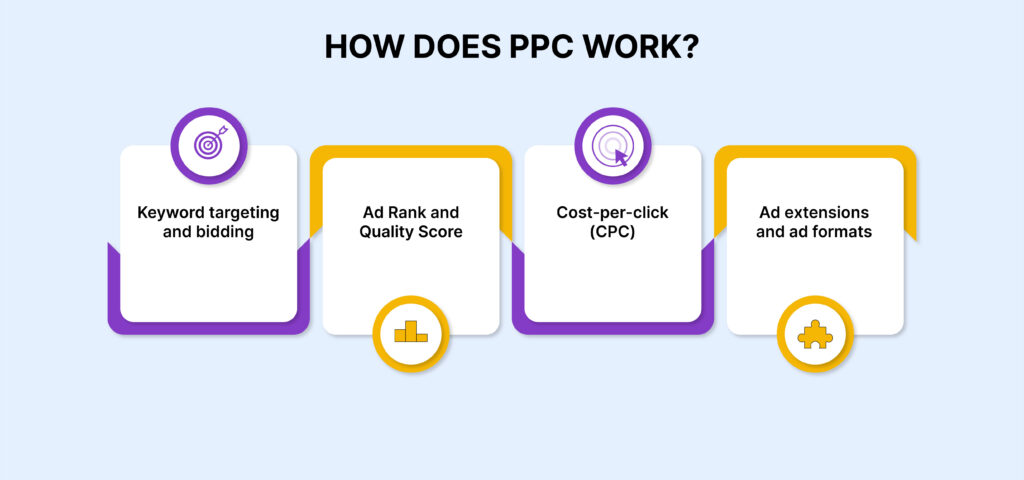
PPC plays a crucial role in digital marketing by providing businesses with a means to increase their visibility, target specific audiences, and drive qualified website traffic.
So, how does PPC work? Let’s take a step-by-step look at the process:
Keyword targeting and bidding
Advertisers select keywords relevant to their business and place bids on them. The bid amount represents the maximum they are prepared to pay when their ad is clicked.
Ad Rank and Quality Score
An auction occur when a user conducts a search query. Ad rank is determined based on various factors such as the bid amount, ad quality, and expected impact of ad extensions. The Quality Score is an essential factor that influences ad rank, considering the relevance and performance of the ad.
Cost-per-click (CPC)
The actual amount an advertiser pays for a click on their ad is determined by the advertiser’s ad rank below them divided by their Quality Score, plus a small increment. This ensures fair competition and prevents advertisers with higher budgets from dominating the results.
Ad extensions and ad formats
Ad extensions provide additional information or features alongside ads, such as links to specific pages on the website, call buttons or location information. Ad formats, including text, images, videos, or a combination of these elements, can vary.
By understanding how PPC works, businesses can optimise their campaigns to achieve better ad positioning and generate higher click-through rates, increasing visibility, traffic, and potential conversions.
Now, let’s explore some of the benefits of PPC in digital marketing.
Benefits of PPC in Digital Marketing
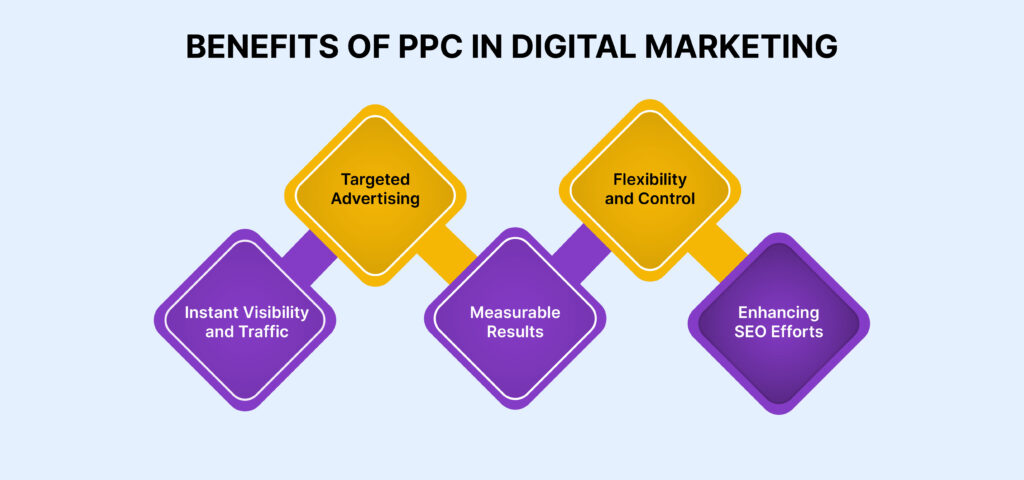
Instant Visibility and Traffic
One of the critical advantages of PPC advertising is its immediate visibility. When businesses launch a PPC campaign, their ads have the potential to be displayed on search engine results pages (SERPs). Within a short period, they ensure exposure to potential customers actively searching for relevant products or services.
Targeted Advertising
PPC allows businesses to precisely target their audience by specifying specific criteria such as demographics, interests, location, and even the time of day. This level of targeting ensures that the ads are displayed to the most relevant audience, increasing the likelihood of engaging potential customers who are more likely to convert.
By leveraging these targeting options, businesses can refine their advertising strategies and deliver personalised messages to the right audience segments, increasing the likelihood of engagement and conversions. This level of precision targeting ensures that the ads reach the most relevant individuals who are more likely to be interested in the products or services offered.
Measurable Results
PPC campaigns provide detailed metrics and insights into ad performance, including impressions, clicks, click-through rates (CTRs), and conversions. This data-driven approach enables businesses to measure the effectiveness of their campaigns, make informed decisions, and optimise their strategies for better results.
Flexibility and Control
PPC offers businesses budget management and campaign customisation flexibility. Advertisers can set their daily or monthly budgets, adjust bids, and make changes to ad copy or targeting parameters in real time, allowing them to adapt to market trends and optimise their campaigns accordingly.
Enhancing SEO Efforts
PPC and search engine optimisation (SEO) are often viewed as separate strategies, each with benefits. However, when used together, they can complement each other effectively and yield even more excellent results.
While SEO focuses on improving organic search rankings, PPC can provide instant visibility on search engine results pages (SERPs). By utilising both approaches, businesses can dominate the search results, occupying valuable space and increasing the chances of attracting clicks and conversions.
Moreover, PPC campaigns provide valuable insights into keyword performance. Businesses can gather data on which keywords drive the most clicks, conversions, and overall success in their PPC campaigns.
This information can be beneficial in identifying high-performing keywords that can be incorporated into their SEO efforts. By aligning their PPC and SEO strategies, businesses can optimise their website content, meta tags, and other SEO elements to improve organic search rankings and attract organic traffic.
The synergy between PPC and SEO is undeniable. While PPC offers immediate visibility and targeted traffic, SEO focuses on building a solid organic presence over the long term. By integrating both strategies, businesses can achieve a comprehensive approach to search engine marketing, maximising their online visibility and driving a steady stream of qualified website traffic.
In summary, PPC and SEO are two powerful tools in the digital marketing arsenal. By combining the instant visibility and precise targeting of PPC with the long-term organic growth of SEO, businesses can create a winning strategy that enhances their online presence, attracts the right audience, and ultimately drives conversions. The key lies in leveraging the insights gained from PPC campaigns to optimise SEO efforts and achieve optimal results in both realms.
Types of PPC ads
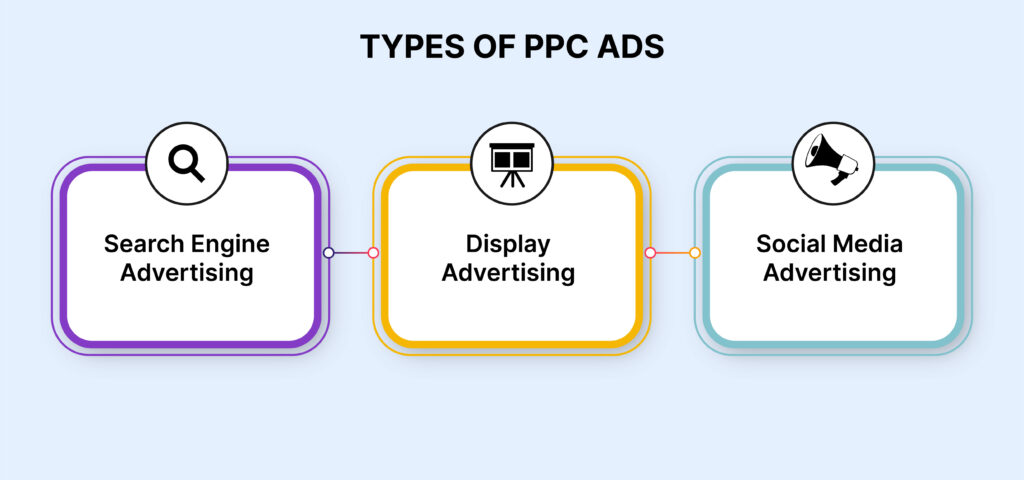
PPC ads come in various formats, catering to different platforms and audience preferences. Here are some common types of PPC ads:
Search Engine Advertising
Paid search, also known as search engine advertising or sponsored search, advertising or search engine marketing, involves displaying ads on search engine platforms. Google Ads and Microsoft Advertising are popular platforms for search engine advertising.
These ads are prominently displayed at the top or bottom sections of the search engine results pages (SERPs), prominently visible to users searching for relevant keywords. Search engine ads give businesses a prime opportunity to grab the interest of potential customers actively seeking products or services.
Display Advertising
Display advertising involves the placement of visual ads, such as images or videos, on websites and apps. Ad networks and programmatic advertising platforms facilitate the distribution of display ads across various websites. Display ads can capture the attention of users.
At the same time, they browse websites, enhancing brand visibility and driving traffic to businesses’ websites. These visually appealing ads can be strategically placed on websites that attract the target audience, increasing the chances of engagement and conversions.
Social Media Advertising
Social media platforms offer robust advertising opportunities, allowing businesses to target their ads to specific user demographics, interests, and behaviours. Ads on platforms like Facebook, Instagram, and other social media channels advertising platforms provide businesses with the means to connect and interact with their desired audience through visually appealing and interactive ads.
These ads can appear in users’ news feeds, stories, or sidebars, allowing businesses to reach potential customers in a more personalised and engaging manner. Social media ads effectively create brand awareness, drive website traffic, and generate leads.
Creating an Effective PPC Campaign
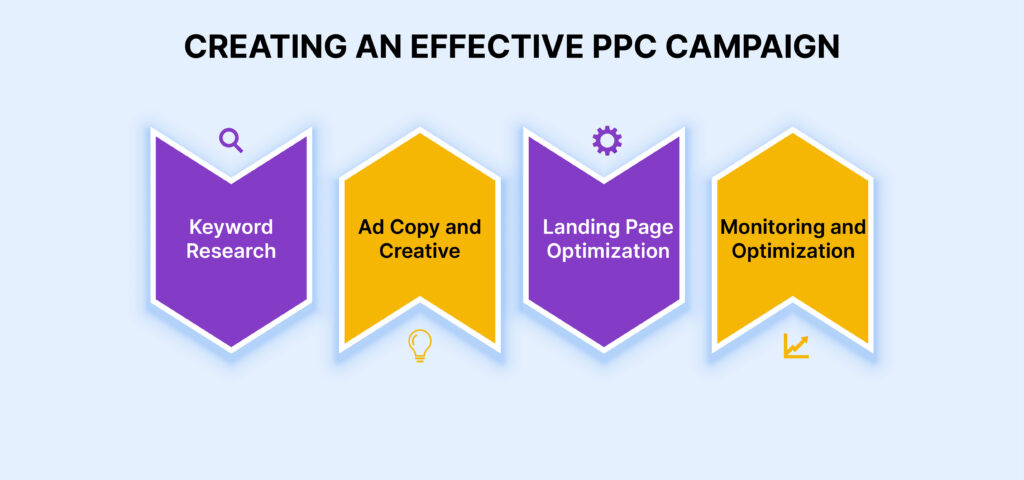
To maximise the effectiveness of PPC campaigns, businesses need to follow a strategic approach. Here are some essential steps to consider when creating a PPC campaign:
Keyword Research
Keyword research is a critical component of PPC campaign planning. By identifying relevant keywords and search queries, businesses can ensure their ads are displayed to users actively searching for their products or services. Different tools for keyword research, like Google Keyword Planner and SEMrush, can help businesses discover relevant keywords and estimate their search volume. Thorough keyword research lays the foundation for a successful PPC campaign.
Ad Copy and Creative
Crafting compelling ad copy is crucial for attracting clicks and driving conversions. Ad headlines should be attention-grabbing, while descriptions should provide clear and concise information about the offerings. It’s essential to highlight unique selling points, differentiate from competitors, and include a strong call-to-action. Additionally, using visually appealing images or videos can enhance the overall impact of the ad and increase engagement.
Landing Page Optimization
Driving traffic to a well-optimised landing page is vital for maximising conversions. The landing page should align with the ad’s messaging, providing a seamless user experience.
It should be crafted to attract visitors’ attention, communicate the value proposition clearly, and make it convenient for users to take the desired action, such as completing a purchase or submitting a form. A well-designed landing page can significantly impact the success of a PPC campaign.
Monitoring and Optimization
Continuously monitoring the performance of a PPC campaign is crucial to identify areas for improvement. Businesses should track key metrics such as click-through rates (CTR), conversion rates, and return on ad spend (ROAS).
Analysing this data allows companies to identify underperforming keywords or ads, make data-driven optimisations, and allocate budgets to the most effective campaigns. Ongoing optimisation is critical to maximising a PPC campaign’s results and returns on investment (ROI).
Conclusion
PPC advertising is a game-changer in digital marketing. It allows businesses to display ads across various online platforms and pay only for clicks. By leveraging the versatility of PPC ads, companies can engage their target audience effectively and achieve measurable results.
With trackability and precise targeting options, PPC empowers businesses to optimise campaigns and drive conversions. Embracing PPC as part of their digital marketing strategy, businesses can maximise online visibility and thrive in the dynamic digital landscape.


